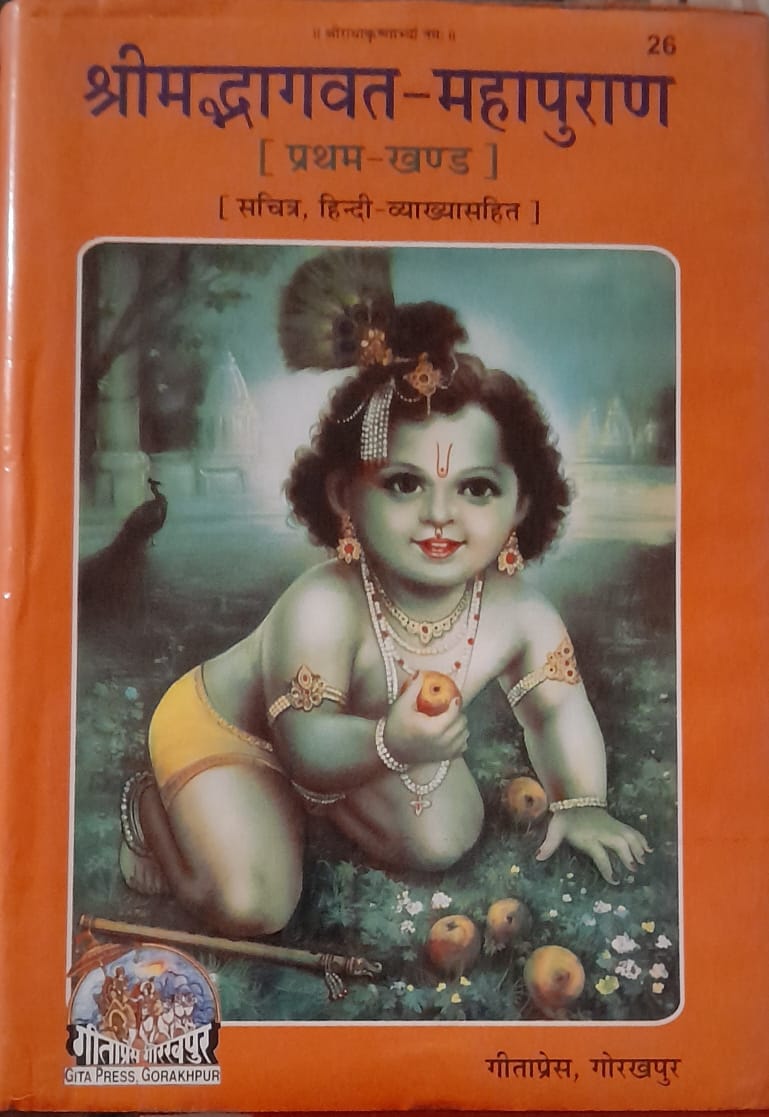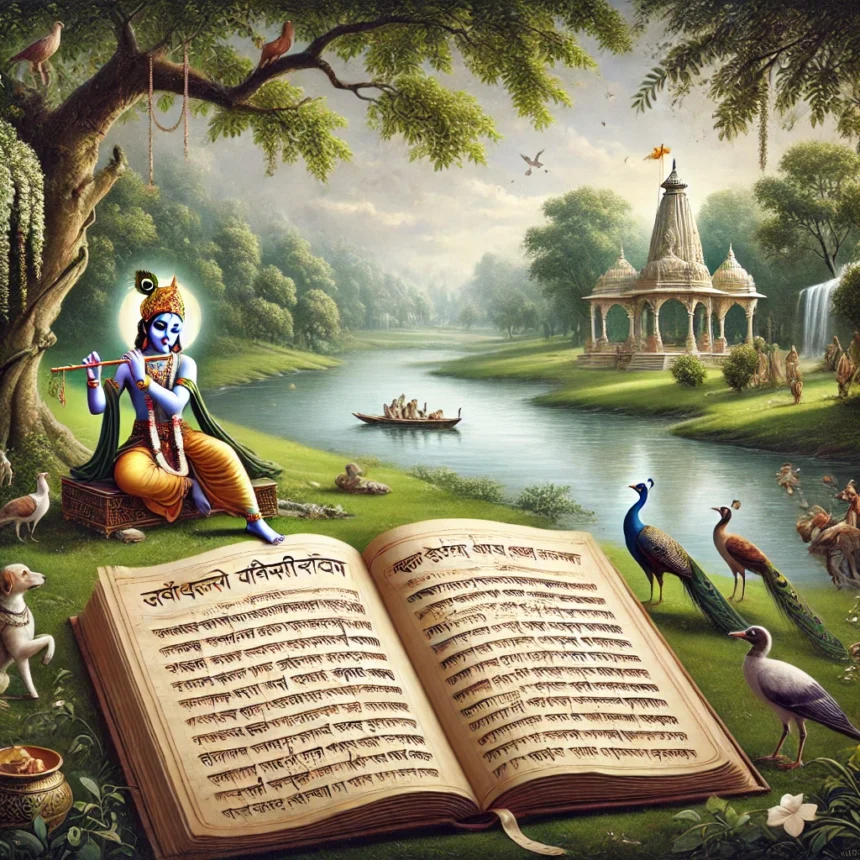Exploring the Timeless Teachings of Shrimad Bhagwat
Shrimad Bhagwat: A Beacon of Vedic Wisdom
As part of our weekly exploration of Hindu Philosophy and Scriptures on HinduInfoPedia.org, this Monday, May 27, 2024, we delve into one of the most venerated texts in Hindu spiritual literature—the Shrimad Bhagwat, also known as the Bhagavata Purana. Esteemed for its deep insights into devotion and righteousness, this sacred scripture is more than just a religious manual; it intricately details the life and teachings of Lord Krishna, serving as a profound guide to spiritual knowledge. Composed in classical Sanskrit by the sage Vyasa, the Shrimad Bhagwat spans twelve extensive cantos, each a treasure trove of philosophical teachings and ethical guidance. Revered not only in spiritual circles but also across the cultural and social spectrums of Indian society, it has shaped arts, music, and the very fabric of public life, promoting a life rooted in ethical living and spiritual depth.
Historical Context and Composition
The Shrimad Bhagwat, penned by the legendary sage Vyasa, is an essential scripture within the rich tapestry of Hindu spiritual texts. As part of the revered eighteen Mahapuranas, this sacred document plays a crucial role in Vaishnavism, particularly in venerating Lord Vishnu and his incarnations, such as Krishna. Its impact extends beyond religious teachings, influencing Indian societal values, arts, and traditions deeply. The Shrimad Bhagwat’s focus on devotion, righteousness, and spiritual knowledge has not only enriched Indian classical arts but also reinforced a societal foundation based on ethical principles and spiritual pursuit, continuing to resonate across generations.
Structure of Shrimad Bhagwat Contents
The Shrimad Bhagwat is divided into twelve books (cantos) and contains approximately 18,000 verses. Each canto focuses on different themes, ranging from cosmology, mythology, and legends to theology, ethics, and devotional practices. Central to the text is the detailed account of Lord Krishna’s life and teachings, along with descriptions of various avatars of Lord Vishnu. Below is a brief overview of the contents of each of the twelve cantos:
First Canto (Adhyatma-vidya):
-
- Introduction to the text, purpose, and the significance of listening to sacred stories.
- The story of King Parikshit and the curse leading to his death.
- The birth of Suta Goswami and his narration of the Bhagavata Purana.
Second Canto (Cosmology):
-
- Descriptions of the material universe and the process of creation.
- The concept of the universal form of the Lord (Virat Rupa).
- Instructions on meditation and the stages of spiritual realization.
Third Canto (Creation and the Form of God):
-
- The process of creation and the activities of Brahma.
- The story of Kapila Muni and his teachings on Sankhya philosophy.
- The activities of Devahuti and Kardama Muni.
Fourth Canto (Genealogies and Stories of Devotees):
-
- The genealogies of different dynasties and the stories of their kings.
- The story of Dhruva Maharaja and his unyielding devotion.
- The story of King Prithu, an ideal ruler and his achievements.
Fifth Canto (Universe and Geography):
-
- Detailed descriptions of the universe, planetary systems, and the different hells and heavens.
- The story of Rishabhadeva and his teachings.
- The account of King Priyavrata and his descendants.
Sixth Canto (Stories of Devotees and Moral Tales):
-
- The story of Ajamila and the power of chanting the holy name.
- The descent of the Ganges and the story of the sons of Sagara.
- The tale of the fallen Vritra and Indra’s quest for forgiveness.
Seventh Canto (Narasimha Avatar and Teachings of Prahlada):
-
- The story of Prahlada Maharaja and his unwavering devotion to Lord Vishnu.
- The appearance of Narasimha Avatar to protect Prahlada and vanquish the demon Hiranyakashipu.
- Various teachings on the nature of the soul and the practice of bhakti.
Eighth Canto (Avatars and Cosmic Deluge):
-
- The story of Gajendra Moksha, where Lord Vishnu rescues an elephant devotee.
- The churning of the ocean (Samudra Manthan) and the appearance of various deities and treasures.
- The narratives of various avatars of Lord Vishnu, including Vamana and Kurma.
Ninth Canto (Dynasties and Stories of Kings):
-
- The genealogies of the Solar and Lunar dynasties.
- Stories of notable kings like Ambarisha, Yayati, and Sudyumna.
- The birth and life stories of Lord Rama and his dynasty.
Tenth Canto (Life and Exploits of Lord Krishna):

-
- The most celebrated canto, focusing on the birth, childhood, and divine play (lila) of Lord Krishna.
- Detailed accounts of Krishna’s adventures in Vrindavan, his interactions with the Gopis, and his victory over various demons.
- The establishment of Krishna’s kingdom in Dwaraka and his role in the Mahabharata.
Eleventh Canto (Uddhava Gita and Final Teachings):
-
- The teachings of Krishna to Uddhava, known as the Uddhava Gita, which covers various philosophical and devotional topics.
- The story of the destruction of the Yadava dynasty.
- The ascension of Krishna back to his divine abode and the departure of the Pandavas.
Twelfth Canto (Future Predictions and Conclusion):
-
- Prophecies about the future, including the degradation of Dharma in the Kali Yuga.
- The final teachings and the summation of the Bhagavata Purana’s core messages.
- The ultimate goal of life, emphasizing the importance of devotion to Lord Krishna for achieving liberation.
Each canto of the Shrimad Bhagwat offers a wealth of spiritual knowledge and insight, making it a comprehensive guide for those seeking to understand the depths of bhakti and the teachings of Lord Krishna. The tenth canto, which describes the life and exploits of Lord Krishna, is particularly celebrated and often considered the heart of the Bhagavata Purana.
Major Sources of Divine Knowledge Within Contents of Shrimad Bhagwat
The Shrimad Bhagwat is distinguished by its profound dialogues, or “samvads,” which form the backbone of its teachings for a common man. The ‘Parikshit and Sukadeva Samvad’ frames the entire text, where Sage Sukadeva enlightens King Parikshit about life, death, and liberation. In the ‘Kapila and Devahuti Samvad’, Lord Kapila expounds on Sankhya philosophy to his mother, Devahuti, detailing the path to spiritual enlightenment. The dynamic ‘Prahlada and Hiranyakashipu Samvad’ showcases the triumph of unwavering devotion over adversity through young Prahlada’s interactions with his demon king father, Hiranyakashipu. The ‘Dattatreya and King Yadu Samvad’ reveals the sage Dattatreya imparting wisdom about detachment and self-realization, drawing from his observations of the natural world. The ‘Vidura and Maitreya Samvad’ provides a discourse on ethics and dharma, as sage Maitreya imparts profound spiritual knowledge to Vidura. Lastly, the ‘Uddhava and Krishna Samvad’, also known as the Uddhava Gita, mirrors the philosophical depth of the Bhagavad Gita, where Lord Krishna elaborates on the concepts of devotion and detachment to his devotee Uddhava. These dialogues not only enrich the philosophical fabric of the Bhagavata Purana but also offer timeless insights into the virtues of righteousness, devotion, and the pursuit of spiritual wisdom.
Core Teachings of Shrimad Bhagwat
Bhakti (Devotion)
One of the central themes of the Shrimad Bhagwat is bhakti, or devotion to God. The text emphasizes the importance of developing a personal relationship with the divine through love, reverence, and surrender. It teaches that bhakti is a powerful means of attaining liberation (moksha) and experiencing divine bliss.
Quote:
शृण्वतां स्वकथाः कृष्णः पुण्यश्रवणकीर्तनः। हृद्यन्तःस्थो ह्यभद्राणि विधुनोति सुहृत्सताम्॥1.2.17॥
“Krishna, who is the friend of the devotees, cleanses the heart of those who hear about him and chant his glories.”
Dharma (Righteousness)
The Shrimad Bhagwat provides extensive teachings on dharma, or righteous living. It discusses the duties and responsibilities of individuals at various stages of life and underscores the importance of moral and ethical conduct. The text guides devotees on how to live a life aligned with dharma to achieve spiritual growth and harmony.
Quote:
धर्मः प्रोज्झितकैतवोऽत्र परमो निर्मत्सराणां सतां वेद्यं वास्तवमत्र वस्तु शिवदं तापत्रयोन्मूलनम्॥1.1.2 (Part)॥
“This scripture rejects all pretentious religiosity and aims at the highest truth, which is understandable by the pure-hearted and brings well-being by uprooting the threefold miseries.”
The Glory of Lord Krishna
Divine Play and Teachings of Lord Krishna
“The Shrimad Bhagavatam is celebrated for its rich, detailed accounts of Lord Krishna’s life—from his miraculous birth and youthful escapades in Vrindavan to his profound role in the Mahabharata and his enlightening discourses like the Bhagavad Gita. This sacred text not only chronicles his divine play (lila) but also illustrates the depth of his teachings which impart wisdom on devotion, dharma, and the path to spiritual liberation.
Krishna’s interactions with his devotees, his playful yet profound dealings with the Gopis, and his guidance to warriors and kings, underline his pivotal role as the supreme personality of Godhead. Each episode of his life offers a unique lesson in spirituality, showcasing how divine love and devotion can transcend the mundane and lead to the ultimate realization of the self.
Quote from the 10th Canto, Srimad Bhagavatam 10.21.5:
बर्हापीडं नटवरवपुः कर्णयोः कर्णिकारं बिभ्रद् वासः कनककपिशं वैजयन्तीं च मालाम्।
रण्द्रान् वेणोरधरसुधयापूरयन् गोपवृन्दैर् वृन्दारण्यं स्वपदरमणं प्राविशद् गीतकीर्तिः॥10.21.5॥
“Krishna, adorned with a peacock feather, wearing golden yellow garments, and with a garland of forest flowers, charmingly plays his flute, filling the holes with the nectar of his lips. As he enters the forest of Vrindavan, enhancing its beauty, he is accompanied by the cowherds, and his fame spreads as he is glorified in song.”
This verse vividly captures Krishna’s enchanting form and divine activities, epitomizing his glory and the profound impact he has on his followers. It underscores how Krishna’s presence and divine play not only enrich the spiritual landscape of Vrindavan but also impart timeless lessons on love, devotion, and the pursuit of spiritual fulfillment.
Relevance of Shrimad Bhagwat in Modern Times
The teachings of the Shrimad Bhagwat are timeless and remain highly relevant in today’s fast-paced world. The emphasis on devotion, righteousness, and ethical living offers valuable guidance for personal and spiritual development. The stories and teachings of Lord Krishna provide inspiration and comfort, encouraging individuals to live with integrity, compassion, and a sense of divine purpose. Additionally, the profound dialogues or “samvads,” within the text—such as those between Lord Kapila and Devahuti, or Krishna and Uddhava—serve as powerful sources of spiritual knowledge, teaching us how to navigate life’s challenges with wisdom and grace.
Reflections of Shrimad Bhagwat Puran
The Shrimad Bhagwat stands as a beacon of divine wisdom, with its rich narratives and teachings guiding devotees toward a life of devotion, righteousness, and ultimate liberation. By embracing its profound dialogues and the stories of Lord Krishna, devotees can experience a deep spiritual transformation and draw closer to the divine. This sacred text is not just a religious cornerstone but also a practical guide for anyone seeking to enrich their spiritual journey and understand universal truths, showcasing its timeless relevance in guiding moral and ethical conduct in contemporary society.
Feature Image: Click here to view the image.
#ShrimadBhagwat #KrishnaTeachings #VedicScriptures #HinduPhilosophy #SpiritualEnlightenment



Leave a Reply